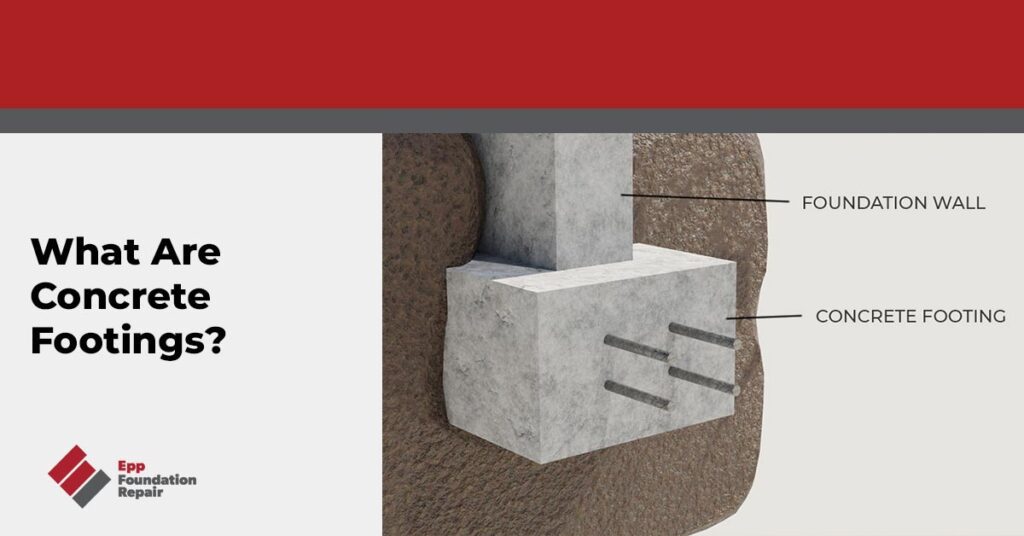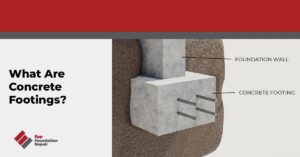Searching for information about concrete footings? If so, don’t hit that back button because you’ve landed on the right page. In this article, we’re going to review what concrete footings are, how they differ from foundations, how concrete footings are built, and more.
What Are Concrete Footings?
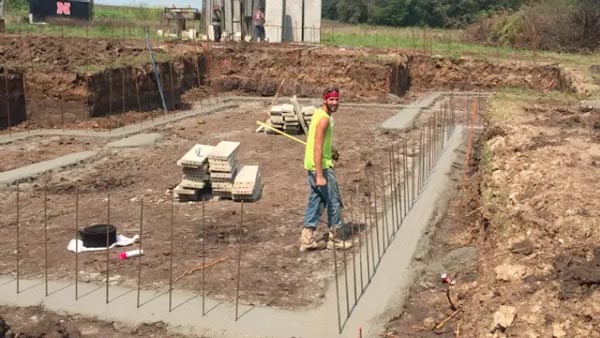
A concrete footing is a structural element that supports the building’s foundation. The footing distributes the building’s weight uniformly. This helps prevent the structure from settling into the ground. Footings are typically made from concrete – with rebar for reinforcement – and installed into a trench excavated to a specific depth. The depth of the footing varies based on factors such as the weight of the building, the type of soil present, whether or not your area is subject to frost depth, and the likelihood of seismic activity.
In addition to providing structural support, concrete footings also help to prevent damage from ground movement, such as earthquakes or settling over time. They also help to prevent moisture and water from seeping into the foundation and causing damage or deterioration.
Proper design and installation of footings is essential to the overall safety and stability of the structure, and failure to properly construct and maintain them can result in structural damage, instability, and even collapse.
Footings Vs. Foundations – What’s The Difference?
The footing and foundation are both crucial in supporting a structure and are fundamental elements of any construction project. However, the footing and foundation differ in many aspects, such as their design, function, material, size, and placement.
The footing is placed beneath the foundation. The footing’s job is to evenly distribute the building’s weight across the ground. It acts as a buffer between the foundation and the ground, preventing structural damage caused by ground movement. The footing is usually wider than the foundation walls.
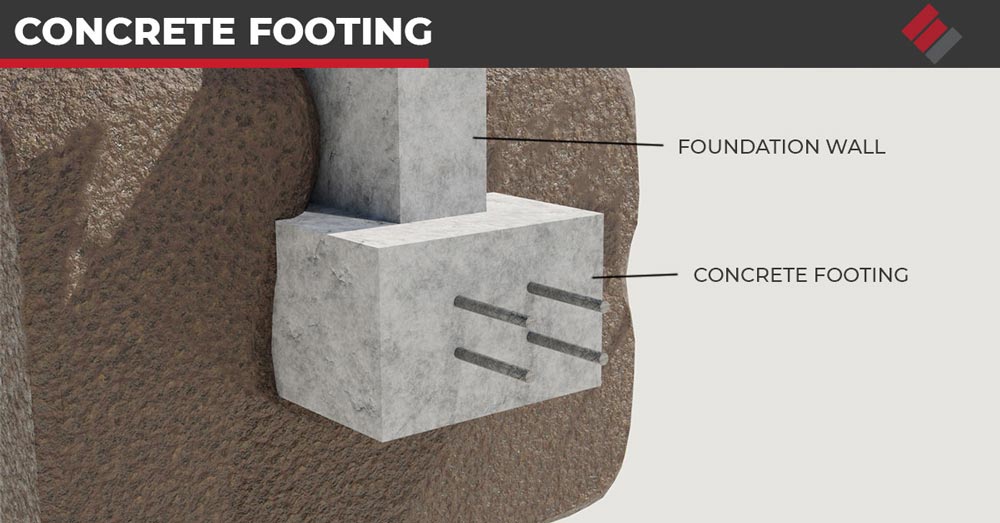
The foundation sits on top of the footing and supports the building. Foundations can be shallow or deep depending on various factors, including the soil type and the structure’s weight. Shallow foundations are suitable for small to medium-sized buildings, while deep foundations are used for tall structures.
Constructing Concrete Footings – Factors To Be Considered
Several things can impact the strength and stability of a footing. These include the following:
- Soil type – Soil type is an essential factor that needs consideration when building a footing. The soil’s bearing capacity can vary depending on its composition, density, and moisture content. The soil type can range from hard and rocky to soft and sandy, and each type requires a different footing design. For instance, if the soil is loose and sandy, then a footing design that is wider and deeper would be needed to ensure stability.
- Building load – Another crucial factor that needs consideration when building a footing is the building load. The footing must support the weight of the building and any additional weight it may bear, such as furniture and people. Consequently, the footing must be designed and constructed to withstand the weight it is required to bear.
- Soil moisture content – If the soil is too dry or too wet, it can impact the soil’s bearing capacity and cause the footing to become unstable. The moisture content of the soil can vary depending on the climate, which brings us to another critical consideration.
- Climate – Climate is a significant factor that impacts footing construction. For example, climate conditions such as severe weather, rain, or frost can affect the ground’s stability and ultimately impact the footing’s strength. Thus, it is necessary to consider the location, climate, and weather patterns when designing and building a concrete footing.
How Homeowners Can Help Prevent Foundation Problems
Things can go wrong even when a footing and structure are built correctly. Believe it or not, water is the most common cause of foundation trouble. When there’s either too much or not enough water in the ground under a foundation, problems can result. By taking steps to control groundwater around your home, you can help prevent foundation trouble and ensure the long-term stability of your property. Here are some ways to do that:
- Clean your gutters regularly – One of the simplest ways to control groundwater is by cleaning your gutters regularly. Over time, leaves, twigs, and other debris can accumulate in your gutters, causing water to overflow and pool around your foundation. You can ensure that rainwater is properly channeled away from your home by cleaning your gutters at least twice a year (more often if you live in a wooded area).
- Install downspout extensions – Another effective strategy is to install downspout extensions. These devices attach to your existing downspouts and direct water further away from your home, helping to prevent moisture buildup in your yard. Be sure to choose high-quality extensions that are correctly sized and installed to ensure maximum effectiveness.
- Regrade the yard around the foundation – Regrading the yard around your foundation can also help control groundwater. If your yard slopes toward your home, rainwater, and other moisture can flow downhill and accumulate around the foundation. You can redirect water and prevent excess moisture buildup by regrading the landscape to slope away from your home.
- Install a drain tile system – Finally, consider installing a drain tile system to help control groundwater around your home. This highly effective foundation waterproofing system is installed underground around the perimeter of your home and helps channel water away from your foundation. A drain tile system is an effective long-term solution for preventing foundation damage and can improve your property’s overall health and stability. For more information, see What Is Drain Tile?
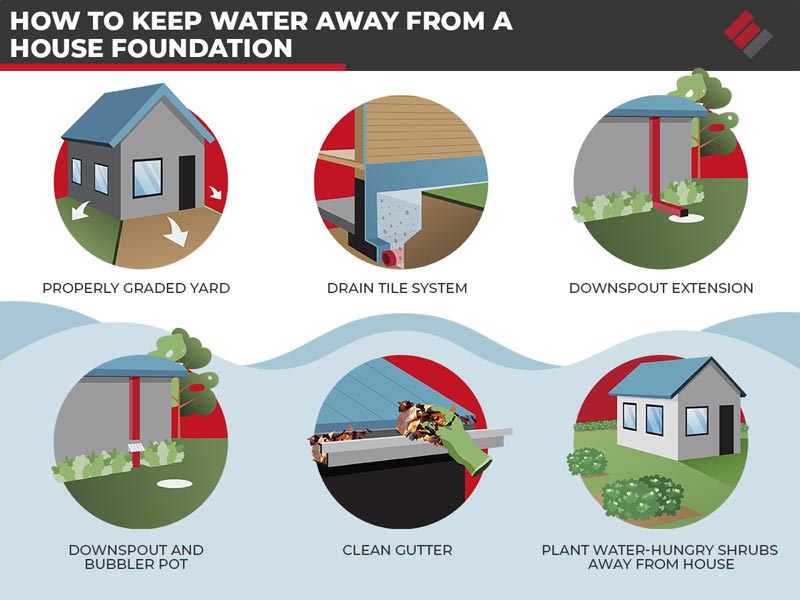
If you think your foundation might have a problem, contact us today to schedule a foundation evaluation. If we find a problem, we’ll give you a repair estimate. We serve areas in four states: Nebraska, Iowa, Kansas, and Missouri.

